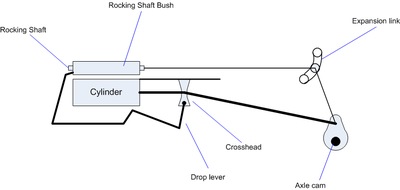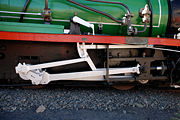
Bagnall-Price valve gear
Encyclopedia
Bagnall-Price valve gear is a type of steam engine
valve gear
developed at locomotive manufacturer W.G. Bagnall
as an alternative to the more common Walschaerts valve gear. The gear was patented in 1903 by W.G. Bagnall and T. S. Price, the manager of the works.

 The valves are driven from an eccentric cam
The valves are driven from an eccentric cam
mounted on one of the driving axles and linkage from the crosshead. The driving axle cam drives a rocking shaft that is mounted inside a cylindrical sleeve (known as the rocking shaft bush) above the cylinder. A drop lever and connecting link from the crosshead oscilates the sleeve to control the lap and lead of the cylinder.
Steam engine
A steam engine is a heat engine that performs mechanical work using steam as its working fluid.Steam engines are external combustion engines, where the working fluid is separate from the combustion products. Non-combustion heat sources such as solar power, nuclear power or geothermal energy may be...
valve gear
Valve gear
The valve gear of a steam engine is the mechanism that operates the inlet and exhaust valves to admit steam into the cylinder and allow exhaust steam to escape, respectively, at the correct points in the cycle...
developed at locomotive manufacturer W.G. Bagnall
W.G. Bagnall
W. G. Bagnall was a locomotive manufacturer from Stafford, England. It was founded in 1875 by William Gordon Bagnall and ceased trading in 1962 when it was taken over by English Electric Co Ltd. The company was located at the Castle Engine Works, in Castle Town, Stafford...
as an alternative to the more common Walschaerts valve gear. The gear was patented in 1903 by W.G. Bagnall and T. S. Price, the manager of the works.
Layout


Cam
A cam is a rotating or sliding piece in a mechanical linkage used especially in transforming rotary motion into linear motion or vice-versa. It is often a part of a rotating wheel or shaft that strikes a lever at one or more points on its circular path...
mounted on one of the driving axles and linkage from the crosshead. The driving axle cam drives a rocking shaft that is mounted inside a cylindrical sleeve (known as the rocking shaft bush) above the cylinder. A drop lever and connecting link from the crosshead oscilates the sleeve to control the lap and lead of the cylinder.

